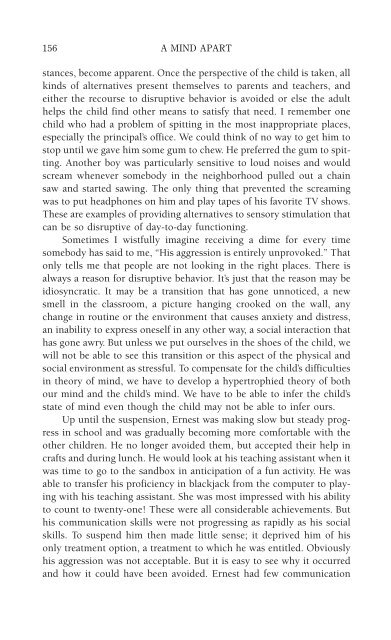978-1572305441
autism
autism
You also want an ePaper? Increase the reach of your titles
YUMPU automatically turns print PDFs into web optimized ePapers that Google loves.
156 A MIND APART<br />
stances, become apparent. Once the perspective of the child is taken, all<br />
kinds of alternatives present themselves to parents and teachers, and<br />
either the recourse to disruptive behavior is avoided or else the adult<br />
helps the child find other means to satisfy that need. I remember one<br />
child who had a problem of spitting in the most inappropriate places,<br />
especially the principal’s office. We could think of no way to get him to<br />
stop until we gave him some gum to chew. He preferred the gum to spitting.<br />
Another boy was particularly sensitive to loud noises and would<br />
scream whenever somebody in the neighborhood pulled out a chain<br />
saw and started sawing. The only thing that prevented the screaming<br />
was to put headphones on him and play tapes of his favorite TV shows.<br />
These are examples of providing alternatives to sensory stimulation that<br />
can be so disruptive of day-to-day functioning.<br />
Sometimes I wistfully imagine receiving a dime for every time<br />
somebody has said to me, “His aggression is entirely unprovoked.” That<br />
only tells me that people are not looking in the right places. There is<br />
always a reason for disruptive behavior. It’s just that the reason may be<br />
idiosyncratic. It may be a transition that has gone unnoticed, a new<br />
smell in the classroom, a picture hanging crooked on the wall, any<br />
change in routine or the environment that causes anxiety and distress,<br />
an inability to express oneself in any other way, a social interaction that<br />
has gone awry. But unless we put ourselves in the shoes of the child, we<br />
will not be able to see this transition or this aspect of the physical and<br />
social environment as stressful. To compensate for the child’s difficulties<br />
in theory of mind, we have to develop a hypertrophied theory of both<br />
our mind and the child’s mind. We have to be able to infer the child’s<br />
state of mind even though the child may not be able to infer ours.<br />
Up until the suspension, Ernest was making slow but steady progress<br />
in school and was gradually becoming more comfortable with the<br />
other children. He no longer avoided them, but accepted their help in<br />
crafts and during lunch. He would look at his teaching assistant when it<br />
was time to go to the sandbox in anticipation of a fun activity. He was<br />
able to transfer his proficiency in blackjack from the computer to playing<br />
with his teaching assistant. She was most impressed with his ability<br />
to count to twenty-one! These were all considerable achievements. But<br />
his communication skills were not progressing as rapidly as his social<br />
skills. To suspend him then made little sense; it deprived him of his<br />
only treatment option, a treatment to which he was entitled. Obviously<br />
his aggression was not acceptable. But it is easy to see why it occurred<br />
and how it could have been avoided. Ernest had few communication



